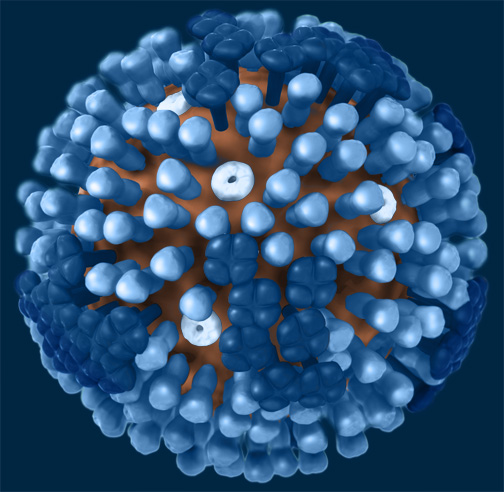Flu Season is here; a quick vaccine reference to avoid an Emergency Room Visit.
By Justin S. Larkin, MD

Graphical Representations of a Generic Influenza Virus-Generic Influenza Virus
Content source: Centers for Disease Control and Prevention, National Center for Immunization and Respiratory Diseases
As the sun sets on summer and the fall weather is now here, this means one thing in the Emergency Departments around the world, Flu Season. Flu related chief complaints during the winter months place a large strain on Emergency Departments around the country.
Often the wait times to be seen and overcrowding of the department occurs, as I am sure many of you have seen or heard about via different media outlets. As an Emergency Medicine Physician I see the waiting room start to fill as the season progresses, which makes it hard to get to all of the needing patients seen in a timely manner. It is often a source of frustration for both the physician and patient to have such long wait times. The physician wanting to help and the patient needing help, however there are just too many patients and not enough room. The one thing that will help the community as a whole, and decrease the burden on the Emergency Systems, is vaccination. There are also some simple things we can do to help prevent the spread of flu.
Do I need a Flu Shot, I got one last year?
The single best way to prevent the flu is to get the vaccine every year. Routine annual vaccination for all persons age 6 months and older is the recommendation from the CDC. Vaccination across the country is getting better overall. Last year the CDC reports that 56.6% of children 6 Months to 17 years were vaccinated and 41.5% of adults age greater than 18 years old were vaccinated. The Influenza viruses vary widely from season to season and from year to year. This is due to the differences in circulating virus types that occur from gene mutation and genetic drift annually. Thus the composition of the Flu Vaccine is changed in most seasons with one or more vaccine strains replaced annually to provide protection against viruses that are anticipated to circulate.
Your flu vaccine that you got last year will not be effective this year. According to the CDC, flu viruses are constantly changing, and different flu viruses circulate and cause illness each season. The annual flu vaccine is updated each year to protect against the flu viruses research indicates will be most common. This is why everyone needs a flu vaccine every year.
As a quick basic science introduction there are three types of Flu that we can contract:
-Type A: Circulates every year and these are described as H and N types. (H1N1)
-Type B: Circulates every year and this causes milder disease then type A
-Type C: Endemic and cases are rare and mild
Every year the World Health Organization in conjunction with the Centers for Disease Control via observational data come up with the most popular strains that will most likely be transmitted.
The 2013-2014 Vaccine Strains for the Northern Hemisphere selected for this year: (Source)
-A/California/7/2009 (H1N1)
-A(H3N2)
-B/ Massachusetts/2/2012
-B/Brisbane/60/2008
Ok I will get a flu shot, so which shot is right for me?
Like everything there has been innovation in this field and there is more and more options for flu shots this year. I will try and break down each option, just remember that the CDC does not recommend one over another, again the most important being just getting any of these shots yearly.
- Standard three-strain (Trivalent) vaccine– This is the standard shot that is injected into our arm. The vaccine protects against three strains of flu, two type A and one type B. Approved for all people ages 6 months and older.
- Standard four-strain (Quadrivalent) vaccine– This year there is a vaccine that protects against four rather than the standard three, it includes an extra type B strain. The vaccine is designed to provide broader protection against circulating influenza type B in seasons during which the type B in the normal three-strain vaccine is not an optimal match the common circulating type B virus. Again type B usually is a mild case of the flu as compared to type A. This is a new vaccine this year and there will need to be some observational studies to see just how much this will help fight the spread of infection. There is limited supply of this vaccine and you should not delay vaccination if you cannot find this particular product. The CDC does not have a preference of the three versus the four strain vaccine.
- High Dose Vaccine– This contains four times the antigen of the standard flu shot. The point of this shot is to help those with weaker immune systems, and it is recommended only those people 65 and older. This will still only have the standard three virus strains selected for this year just a lot more of the antigen.
- Nasal Spray vaccine– if you hate needles, healthy, ages between 2 and 49, not pregnant then this is an option. This is a quadrivalent vaccine and will protect the four strains of virus selected for the year.
Where and when can I get the Flu Shot?
The flu vaccine usually becomes available in late September and you should have your vaccine by October. Most of the flu outbreaks occur in January, so that is why we suggest getting the vaccine early. The vaccine usually takes about two weeks for your body to make the antibodies to protect you from the flu.
Here is a link to show you where you can a vaccine in your neighborhood: vaccine.healthmap.org
Oh wait! I have an egg allergy….
This year there is also an egg free dose trivalent vaccine. The vaccine is called Flublok which has three strains of virus protein. This is only recommended for those with non anaphylactic reaction to eggs and ages between 18 and 49.
I heard that the flu shot will make me feel sick?
Depending on the shot there are some side effects. Most people that get the muscle shot have reported soreness, redness, swelling over the area where the shot was given. There are some reports of headache, muscle aches, fever and nausea. This usually occurs soon after the shot and last no more then 1-2 days. Those patients that received the nasal spray vaccine report having runny nose, headache, sore throat and cough. As with any medical intervention there is a risk of allergic reaction and if you show any signs of allergic reaction or unusual conditions that you have following the vaccine you should seek medical attention right away.
About Justin Larkin, MD
 Dr. Justin Larkin is currently a Senior Emergency Medicine Resident in Washington, D.C. at the George Washington University Hospital. Dr. Larkin completed his undergraduate work at the University of California at Berkeley. He then went on to complete his medical degree at the George Washington University. During his Emergency Residency, Dr. Larkin developed an interest in medical journalism and now is in the process of exploring different types of medical media at Healthin30.com. His interests are in the dissemination of information to the masses of both sides of the bedside, the physician experience and the patient experience.
Dr. Justin Larkin is currently a Senior Emergency Medicine Resident in Washington, D.C. at the George Washington University Hospital. Dr. Larkin completed his undergraduate work at the University of California at Berkeley. He then went on to complete his medical degree at the George Washington University. During his Emergency Residency, Dr. Larkin developed an interest in medical journalism and now is in the process of exploring different types of medical media at Healthin30.com. His interests are in the dissemination of information to the masses of both sides of the bedside, the physician experience and the patient experience.
—
Centers for Disease Control and Prevention (CDC)
What You Should Know for the 2013-2014 Influenza Season
Your turn
As always, thank you for your valuable time. We would love to hear you. Please share your thoughts and questions in the comment section below.
(For more specific information regarding what’s best for you, talk to you doctor, nurse or other health care provider.)
Up next…Information on Thimerosal, what you can do to prevent the spread of germs and the right way to wash your hands.
